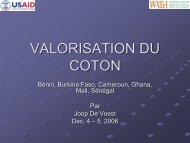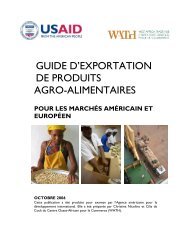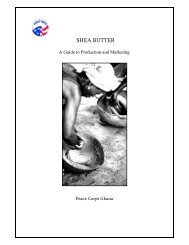A Brief Introduction to Textile Processing - AGOA Export Toolkit
A Brief Introduction to Textile Processing - AGOA Export Toolkit
A Brief Introduction to Textile Processing - AGOA Export Toolkit
You also want an ePaper? Increase the reach of your titles
YUMPU automatically turns print PDFs into web optimized ePapers that Google loves.
Fiber characteristics<br />
<strong>Textile</strong> manufacturers engineer fabrics <strong>to</strong> have certain characteristics, according <strong>to</strong> the needs of the<br />
end – user. Fabric <strong>to</strong> be used in apparel will be engineered for comfort. Depending upon the<br />
intended use of the garment (e.g. children’s play clothes, or ladies’ evening wear) certain<br />
characteristics may be more important, or less important (durability, washability, fabric luster or<br />
shine.) This engineering process begins with the careful selection of fibers, according <strong>to</strong> their<br />
characteristics, and continues through the choice of yarn type and size, method of fabric<br />
construction, dye selection and dyeing or printing methods, and so on.<br />
Chemical characteristics. Fibers may be categorized as being hydrophilic (easily absorbing water),<br />
hydrophobic (not easily absorbing water), or oleophilic (easily absorbing oil, and hence oily stains). Such<br />
differences play a key role in how easily a fabric or garment may become soiled, whether it absorbs<br />
oily substances that easily stain or mark a fabric and may be difficult <strong>to</strong> remove. They play a vital role<br />
in whether a garment can be laundered (washed with water and detergent) or must be dry cleaned<br />
with chemical solvents. Many consumers dislike the latter because of the expense and concerns about<br />
the environmental impact of chemicals used in the dry cleaning process.<br />
Most natural fibers are hydrophilic, that is <strong>to</strong> say they absorb water easily. Polyester is notably<br />
oleophilic, meaning it easily absorbs oil, making it less desirable for certain types of apparel or home<br />
furnishings uses. These characteristics also make it important for manufacturers <strong>to</strong> select the proper<br />
dyes for coloring a yarn or fabric, as the chemical make – up of the dye must be compatible with the<br />
chemical make – up of the fiber (whether the fiber is natural or man – made). If a garment is <strong>to</strong> be dyed<br />
after assembly (either garment dyed or over – dyed), it is particularly critical that the thread used for sewing the garment<br />
be made from a fiber with the same characteristics and dyeability as the fabric. Otherwise, quality problems will occur<br />
during the dyeing process, causing unsightly color defects in the finished garment. This is equally important in selecting<br />
embroidery threads for any fabrics or garments that will be dyed after being embroidered.<br />
It is also vitally important <strong>to</strong> consider fiber content when selecting fibers <strong>to</strong> be used in swimwear. It<br />
can be expected that swimwear will be exposed over prolonged periods of time <strong>to</strong> salt water,<br />
chlorine, and sun. Any one of these in isolation or in combination can be highly degrading <strong>to</strong> certain<br />
fibers (and dyes). Care should be taken <strong>to</strong> select those fibers (hence fabrics) that can withstand such<br />
agents without degradation or loss of quality.<br />
Physical characteristics. Each type of fiber also has its own physical characteristics of strength,<br />
luster, softness or rigidity, surface feel, etc. This makes some fibers more suitable <strong>to</strong> certain types of<br />
apparel than others. For example, cultivated silk is known for its smoothness and luster, but many<br />
animal hairs (wool, camel, etc.) often have a scratchy feel due <strong>to</strong> their irregular, scaly surface.<br />
Figure 3. Drawing of wool fibers Figure 4. Drawing of a silk fiber<br />
An overview of fiber characteristics follows. Fashion and clothing designers will select and specify a<br />
particular type of fabric, including its fiber content, yarn size, method of fabric construction, dye<br />
type, and dyeing or printing method according <strong>to</strong> the characteristics s/he wants in the finished<br />
garment.<br />
Designers wanting a finished garment that is cool, comfortable, and easily washed may select a100%<br />
cot<strong>to</strong>n, or a blended fabric (two or more fiber types in the same yarn or fabric) containing a high<br />
Prepared by Margaret Bishop and Brent Smith for the West Africa Trade Hub 8/04 3









